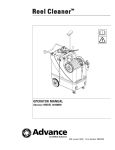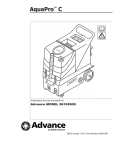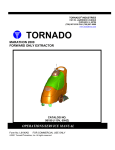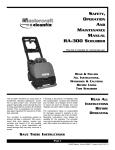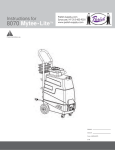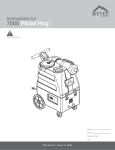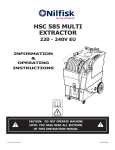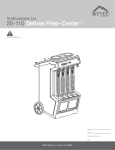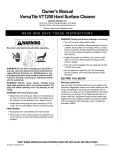Download Clarke TFC 400 Specifications
Transcript
TFC 400 OPERATOR MANUAL Clarke MODEL 56380773 11/09 Rev C Document Number 56380889 IMPORTANT SAFETY INSTRUCTIONS This machine is only suitable for commercial use, for example, in hotels, schools, hospitals, factories, shops, and offices other than normal residential housekeeping purposes. When using an electrical appliance, basic precautions should always be followed, including the following: READ ALL INSTRUCTIONS BEFORE USING THIS MACHINE. WARNING To reduce the risk of fire, electric shock, or injury: • Always use the power cord that comes with the machine and includes a GFCI (Ground Fault Circuit Interrupter). Never use the machine without connecting to power through a GFCI. • Do not leave the machine when it is plugged in. Unplug the unit from the outlet when not in use and before servicing. • To avoid electric shock, do not expose to rain or snow. Store and use indoors. • Do not allow to be used as a toy. Close attention is necessary when used near children. • Use only as described in this manual. Use only the manufacturer’s recommended attachments. • Do not use with a damaged cord or plug. If the appliance is not working as it should, has been dropped, damaged, left outdoors, or dropped into water, return it to a service center. • Do not pull by the cord, use the cord as a handle, damage the cord, or allow the cord or the machine near heated surfaces. • Do not unplug by pulling on the cord. To unplug, grasp the cord end. • Do not handle the plug, the cord, or the machine with wet hands. • Do not put any objects into openings. Do not use with any opening blocked; keep free of dust, lint, hair, and anything that may reduce air flow. • Keep loose clothing, hair, fingers, and all parts of your body away from the openings and moving parts. • Do not pick-up anything that is burning or smoking, or any health endangering dusts. • Turn off all controls before unplugging. • Always use chemicals with a pH between 4 and 12, and never introduce the chemicals in the tank. Always use the chemical siphoning system. • Use extra care when cleaning on stairs. • Do not use to pick up flammable or combustible liquids, and do not use in any areas where these may be present. • If foam or liquid comes out with the vacuum exhaust, switch the power off immediately. Verify that there are not foreign objects from preventing the float ball from moving freely. Contact Clarke if the problem persists. • Liquid ejected at the spray nozzle could be dangerous as a result of its temperature, pressure, or chemical content. SAVE THESE INSTRUCTIONS 2 INTRODUCTION This manual will help you to get the most from your Clarke All Purpose Cleaner. Read it thoroughly before operating the machine. This product is intended for commercial use only. PARTS AND SERVICE Repairs, when required, should be performed by Clarke service personnel using original replacement parts and accessories. Call Clarke for repair parts or service. Please specify the Model and Serial number when calling about your machine. NAME PLATE The model and serial number of your machine are shown on the Name Plate on the machine. This information is needed when ordering parts for the machine. Use the space below to note the model and serial numbers of your machine. MODEL NUMBER/NAME: __________________________________________________ SERIAL NUMBER: ________________________________________________________ NAME AND PHONE NUMBER OF YOUR DISTRIBUTOR: ______________________________ UNPACKING When the machine arrives, carefully inspect the shipping carton and the machine for damage. If damage is evident, save the shipping carton so that it can be inspected by the carrier. Contact the Clarke customer service department immediately to file a freight damage claim. DO NOT OPERATE THE MACHINE UNTIL YOU HAVE READ THIS SECTION IMPROPER USE WILL VOID THE WARRANTY • Always use a defoamer when foaming occurs to prevent vacuum motor damage. • To keep fittings, pumps, and lines from damage during freezing conditions, use RV anti-freeze in the pump or keep the machine inside heated areas. • Do not let the pump run dry. • All chemicals should be added through the feed system and NOT in the tank. • All extension cords must have a rating of at least 12/3 (12 gauge cord). Extension cords should be no longer than 50 feet. Replace the plug immediately if the ground prong becomes damaged or is broken off. • DO NOT use water heated to greater than 120 °F (50 °C). 3 KNOW YOUR MACHINE DESCRIPTIONS Operator Handle (1): Operator holds onto this handle to move the machine from one location to another. Solution Tank Lid (2): This lid screws off so the tank can be filled. The solution fill hose is tethered to the lid, and hangs inside the arm of the Operator Handle. Tools & Accessories (3): Various accessories can be stored on the machine. Basket (4): This lift-off carrying basket sits on top of the round lid on the Recovery tank. Recovery Hose (5): Waste water is picked-up through this hose. Chemical Container Holders (6): Two molded-in bottle holders for chemical jugs. Spray Hose (7): This hose delivers water from the machine to the cleaning tool. Drain Hose (8): This hose is used to empty the recovery tank. NOTE: hold the end of the hose above the water level in the tank to avoid sudden, uncontrolled flow of waste water when you remove the cap, then lower the hose slowly to control the rate of discharge. Quick Disconnect (9): Point of attachment for the Spray Hose (7). Switch Plate (10): The machine’s on/off switches for the vacuum and for the pump are located here and this is where the valve to change chemical feeds is located. Castors and Wheels (11): Castors pivot for ease of steering, and large back wheels make it easy to roll the machine from location to location. Switch Plate (10): The machine’s on/off switches for the vacuum and for the pump are located here and this is where the valve to change chemical feeds is located. Power Cord (12): The 25 ft. power cord connects to a power cord pigtail on the rear of the machine. 3 1 12 5 2 4 6 7 9 8 10 11 4 KNOW YOUR SWITCH PLATE 2 1 I 4 O O 3 Vacuum Switch (1): turns on the vacuum motor. Chemical Valve (2): switches between the two chemical containers. When the selector is pointed straight down, the valve is off and neither chemical is selected. When the selector is pointed directly towards one or the other symbols, that chemical is selected. Solution Pump Switch (3): turns on the solution pump. Quick Connect (4): this is where solution comes out of the machine and the attachment point for the solution hose. METERING TIPS The chemical metering tips allow you to select the ratio of chemical to water, as the water flows out of the machine. Insert the correct metering tip for the desired mixture into the chemical siphon tube. METERING TIPS COLOR Orange Pink Dark Green Yellow Light Blue Burgundy Black HOLE SIZE 0.007 0.012 0.014 0.016 0.020 0.022 0.048 MIX RATIO 1 oz : 128 oz 1 oz : 64 oz 1 oz : 50 oz 1 oz : 32 oz 1 oz : 20 oz 1 oz : 15 oz 1 oz : 5 oz 5 FLOW RATE 1.0 oz/gal 2.5 oz/gal 3.0 oz/gal 5.0 oz/gal 6.0 oz/gal 9.0 oz/gal 20 oz/gal OPERATION 1) Insert the appropriate metering tips into the chemical feed lines (see illustration, page 5). 2) Fill the holding tank with warm water (not exceeding 120 °F). Do not add any chemical to the tank. 3) Prepare the area for cleaning by emptying waste receptacles, clearing debris, removing paper products, blowing out vents, and sweeping floors. 4) Connect the 25 ft power cord to the pig-tail on the rear of the machine. Test the GFCI on the power cord before each use. Plug the GFCI protected power cord into an outlet. 5) PRIME THE PUMP: Attach the priming hose to the outlet quick disconnect and place the open end of the hose into the recovery tank. Turn on the pump and let it run until the pump is completely primed (no visible air in the water stream). Turn the pump off. NOTE: prime the machine before you place the chemical feed tubes into chemical containers. Disconnect the priming hose and attach the solution hose to the quick disconnect. Attach the spray gun to the other end of the solution line. Place chemicals in the molded-in chemical bottle containers on the rear of the machine. Insert one of the feed lines into one of the chemical containers. Secure the line by screwing on the cap. The chemical will feed from which ever container the selector valve on the switch plate is turned towards and when the gun is used in the low pressure setting. Use chemicals with a pH of between 4 and 12. Never add chemicals to the clean water tank. Set the spray gun to low pressure by sliding the pressure selector forward (low pressure = forward; high pressure = back). Turn on the pump switch (push button) and spray through the gun for a few seconds to fill the line with solution. Apply the chemical to the walls and fixtures from the bottom up. Spray the floor last as you work your way out of the room. Allow the chemical to work for the proper amount of dwell time, according to the chemical manufacturer’s directions. Agitate heavily soiled areas with a scrub brush. Turn off the chemical injector valve by turning the selector to the down position. Set the spray gun to high pressure and rinse the area from the top down. Connect the vacuum hose, attach the squeegee, and turn on the vacuum (rocker switch). Squeegee off the mirrors, pick up the liquid off the floor with the floor tool. If you have the optional blow dry hose, use it to dry the fixtures. Drain the recovered water into a utility sink or toilet. NOTE: Keep the top of the drain hose higher than the water level in the tank to avoid uncontrolled discharge of water when you open the cap on the hose. 6) 7) 8) 9) 10) 11) 12) 13) 14) 15) 16) 17) CAUTION To avoid vacuum motor damage, always use a defoamer any time foam is present. Before you turn on the vacuum always make sure the filter screen on the ball float is clean and that the ball can travel freely. RE-PRIMING THE PUMP If the pump looses prime between jobs, follow the instructions to PRIME THE PUMP, above. If that doesn’t get water flowing, put the priming hose into the vacuum inlet hose barb and cover the rest of the space around the priming hose with your hand. Turn on the vacuum (with the pump also running) and let the suction of the vacuum assist in getting water into the pump. 6 7 19 10 28 56380773 TFC-400 7 8 1 9 2 18 29 6 20 15 26 21 17 5 16 22 11 3 23 24 12 23B 13 27 4 11-04-09 25 14 PART LIST ITEM PART No. QTY 1 2 3 4 5 6 7 8 9 10 11 12 13 14 15 16 17 18 19 20 21 22 23 23B 24 25 26 27 28 29 56380907 56380780 56380782 56380774 56380783 56380909 56380912 56380924 56380919 56380939 56380930 56380793 56380843 56380841 56380923 56380908 56380902 56380929 56380805 56380787 56380934 56380797 56380798 56380894 56380935 56380799 56380925 56380913 56380940 56380941 1 1 1 1 1 1 1 1 1 1 1 1 1 1 1 1 1 1 1 1 1 1 1 1 1 1 1 1 1 1 DESCRIPTION Lid and gasket, recovery tank Hose kit, drain, priming and vac inlet Hose kit, water inlet and chemical metering Power cord, 25 ft, with GFCI Pig Tail, for Power cord, with cord retainer Vacuum motor kit, with gasket and hose Tank, Recovery, complete Vacuum inlet kit Switch plate kit, complete Switch kit, three switches Pallet, component mounting, empty * Lid, with fill hose, holding tank/base Fasteners kit Lid and ring, 4” Pump and motor, 400 psi, complete Motor, DC, pump drive Pump, 400 psi, complete, no motor Filter, pump in-line, with hoses Hose, vacuum, 25 ft, complete with cuffs Quick disconnect kit, with washers Grommets and foam Cap, drain, and brass fitting Castor kit Castor/Squeegee mounting plate Holding tank/base Wheel kit Pressure regulator, for 400 psi pump Chemical Injector and Metering Tip kit Gun sleeve and gaskets Seals and rivets, for switch plate MISCELLANEOUS PARTS 56380921 *56380928 Label kit, “TFC 400” & warning Pallet assembly with components, complete REV C 11-2009 8 TOOLS Tool Kit, standard, complete -- # 56380937 7 10 1 3 4 2 8 5 9 6 1 2 3 4 5 6 7 8 9 10 11 12 56380854 56380853 56380838 56380855 56108027 56108028 56108072 56380802 56108024 56380852 56380805 56380938 Squeegee, hand-held, 12” Handle, 12”, for hand squeegee Solution hose, complete, 25 ft Brush, dual surface, polypropylene Wand, two-piece, snap fit Squeegee,14’, for floor Spray gun, complete Metering tip kit, two each of seven sizes Priming hose assembly, for 400 psi pump Handle, black, 54” Recovery hose, 25 ft Tote box 12 OPTIONAL ACCESSORIES 1 2 3 4 5 6 56380856 56380857 56380888 56209089 56380871 56380877 Mop frame Mop, microfiber, package of six Squeegee assembly, 24” Squeegee assembly, 30” Mount assembly, mechanical, for squeegee head Blower hose assembly, with nozzle 6 1 4 2 3 5 9 11 MAINTENANCE 1) Use only approved chemicals at the recommended mix ratios. All chemicals should be added through the feed system and NOT added directly to the water in the solution tank to prevent possible damage to the pump, seals, or other components. 2) For optimum performance, flush the Chemical Feed lines after every job by replacing the chemical containers with containers of clear water and spraying through the gun until the fluid stream is clear. See the Maintenance Schedule, below. 3) The pump seals and/or valves in the high pressure pumps may need to be replaced after about 1000 hours of use, if the pump begins to loose performance or to leak. The pressure regulator valve may need to be when a drop in the spraying pressure at the tool is apparent. 4) If the 4”, clear lid is removed from the top of the base (solution tank), you will need to apply a silicone sealant to the threads when you reinstall the lid to seal for vacuum leaks. MAINTENANCE SCHEDULE ITEM DAILY WEEKLY QUARTERLY YEARLY x x Flush chemical lines Check/clean vac inlet filter Clean solution filter Check vacuum motor airways Check pump for leaks Check vacuum motor brushes * x x x x * Have Clarke check the carbon brushes once a year or after about 500 hours of operation. TECHNICAL SPECIFICATIONS Vacuum motor: Water lift: Air flow: Tank constructions: Solution tank capacity: Recovery tank: capacity: Application flow: Vac & Solution hose length: Power cord: Height: Width: Length: Machine weight: 2-stage, 8 amp 97” 100 CFM Rotationally molded polyethylene 20 gallon 13 gallon 400 psi 25 feet 25 feet 38.5 inches 21.25 inches 34 inches 92 lbs 10 NOTES: 11 Clarke® U.S. WARRANTY This Clarke Industrial/Commercial Product is warranted to be free from defects in materials and workmanship under normal use and service for a period of three years from the date of purchase, when operated and maintained in accordance with Clarke’s Maintenance and Operation instructions. This warranty is extended only to the original purchaser for use of the product. It does not cover wear parts such as electrical cable, rubber parts, hoses, and motor brushes. If difficulty develops with the product, you should: (a) Contact the nearest authorized Clarke repair location or contact Clarke Service Operations Department 14600 21st Avenue North, Plymouth, MN 55447, for the nearest Clarke repair location. Only those locations are authorized to make repairs to the product under this warranty. (b) Return the product to the nearest Clarke repair location. Transportation charges to and from the repair location must be prepaid by the purchaser. (c) Clarke will repair the product or replace any defective parts without charge within a reasonable time after the receipt of the product. Clarke’s liability under this warranty is limited to repair of the product and/or replacement of parts and is given to the purchaser in lieu of all other remedies, including INCIDENTAL AND CONSEQUENTIAL DAMAGES. THERE ARE NO EXPRESS WARRANTIES OTHER THAN THOSE SPECIFIED HEREIN. THERE ARE NO WARRANTIES WHICH EXTEND BEYOND THE DESCRIPTION OF THE FACE HEREOF. NO WARRANTIES, INCLUDING BUT NOT LIMITED TO WARRANTY OF MERCHANTABILITY, SHALL BE IMPLIED. A warranty registration cared is provided with your Clarke product. Return the card to assist Clarke in providing the performance you expect from your new machine. CLARKE®, 14600 21st Avenue North, Plymouth, MN 55447 Clarke® reserves the right to make changes or improvements to its machine without notice. Always use genuine Clarke® parts for repair. 14600 21st Avenue North Plymouth, MN 55447 12












